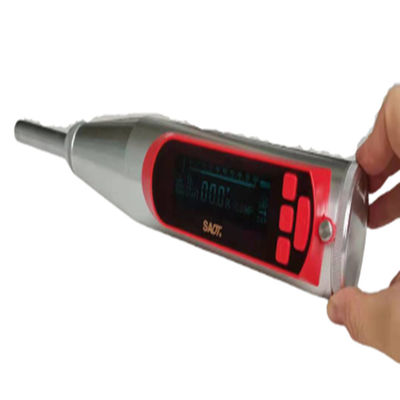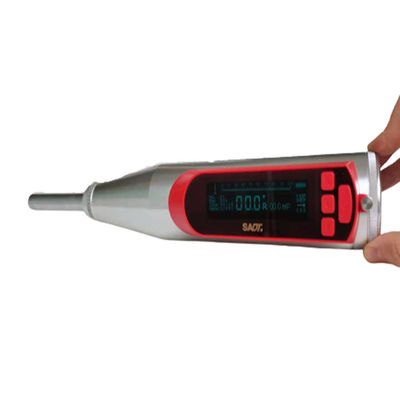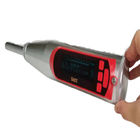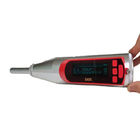-
Portable Hardness Tester
-
Portable Leeb Hardness Tester
-
Hardness Tester
-
Ultrasonic Thickness Gauge
-
Concrete Test Hammer
-
Brinell Hardness Testing
-
Rockwell Hardness Tester
-
Vickers Hardness Tester
-
Gloss Meter
-
Color Difference Meter
-
Metallurgical Microscope
-
Surface Roughness Tester
-
Ultrasonic Flaw Detector
-
Portable Vibration Meter
-
 Paul FrameThank you very much for all your help regarding the SADT Concrete Hammer and hardness tester which are working well and we are very pleased with it.
Paul FrameThank you very much for all your help regarding the SADT Concrete Hammer and hardness tester which are working well and we are very pleased with it.
CE ISO9001 Concrete Strength Test Hammer Automatic Calculating Automatic Correction

Contact me for free samples and coupons.
Whatsapp:0086 18588475571
Wechat: 0086 18588475571
Skype: sales10@aixton.com
If you have any concern, we provide 24-hour online help.
x| Language | English | Display | OLED |
|---|---|---|---|
| Accuray | +/-0.1R | Memory | 1000 Parts, 256 Data For Each Part |
| Measuring Range | 10-100N/mm2 | Impact Energy | 0.225kgm (2.207Nm) |
| Communication | USB2.0 Or Bluetooth | Certification | ISO9001/CE/SGS |
| Warranty | 1 Year | ||
| Highlight | integrated digital concrete test hammer,bluetooth concrete strength test hammer,integrated concrete strength test hammer |
||
Introduction
HT-225DS Digital Rebound Apparatus is a product designed according to Technical Regulations for Concrete Compressive Strength Test by Rebound Method (JGJ/T23-2001) (hereinafter referred to as Regulations) and developed in order to meet actual requirements for the field test of concrete compressive strength, applicable to the non-destructive testing of common concrete compressive strength in all kinds of construction engineering. It is specifically applicable to the on-site quality sampling inspection by Engineering Quality Supervision Institutions and Supervising Units, for the compressive strength test result of the inspected concrete structure can be got immediately; when the Construction Quality Testing Institution carries out on-site test for real construction objects, it can further reflect the fairness, scientificity and accuracy of the test, greatly imformation.
Key feature
High contrast OLED display
All setup can be made on site
Automatic calculating compressive strength
Automatic correction of impact direction
All data will be stored in memory
All data can be transferred to PC by USB cable or Bluetooth
Dual display for analogue ruler and digital value
Digital/Mechanical 2-in-1
Specification
| Model | HT-225DS | HT-225D | HT-75D | HT-20D |
| Type | Digital/Mechanical 2-in-1 | Digital Only | ||
| Display | OLED digital | |||
| Measuring range | 10-100N/mm2 | 1-25N/mm2 | ||
| Accuracy | ±0.1R | |||
| Impact energy | 0.225kgm (2.207Nm) for testing ordinary building and bridge construction | 0.075kgm (0.735Nm) for testing small and impact-sensitive parts of concrete or artificial brick | 0.020kgm (0.196Nm) for testing mortar products | |
| Communication | USB2.0 or Bluetooth | |||
| Printing | Bluetooth micro printer (optional) | |||
| Storage | 1000 parts, 256 data for each part | |||
| Operating temperature | -40º-60ºC | |||
| Power supply | 3.7V Li-ion rechargeable battery charged via USB port | |||
| Dimension (mm) | 280x75x60 | |||
Standard package
HT-225DS/HT-225D/HT-75D/
HT-20D
main unit 1
Grinding wheel 1
USB cable 1
USB charger 1
Software CD 1
Operation manual 1
Carrying case 1
Parameter Specification
Test times (test point), for each test point in each testing zone, according to Regulations, the test times are 16.
Testing zone, a test unit for testing concrete compressive strength of structure or component, with an appropriate area no more than 0.04㎡.
Equivalent value of concrete strength in testing zone refers to the concrete compressive strength value of the tested unit calculated based on the average rebound value and carbonization depth of testing zone via strength-measuring curve.
Test angle, casting surface, if the rebound apparatus is not in horizontal direction or the tested surface is non-concrete casting side, after setting the test angle and casting surface respectively, the apparatus can automatically conduct angular correction and casting surface correction of rebound value.
Carbonization depth: concrete carbonization depth is a kind of chemical corrosion of concrete, and the process reducing concrete alkalinity is called concrete carbonization. Carbonization depth value can be obtained according to the relevant methods of Regulations. When input
carbonization depth, only have to input a number betwee in 0.0mm and 6.0mm and then the apparatus can, according to the input carbonization depth value, calculate the concrete compressive strength value..
Test of pump concrete strength, set the curve as “national-pumping”.
According to the Regulations, the apparatus calculate the corrected value of pump concrete strength and strength-measuring curve, and the calculated concrete compressive strength value is the strength value of pump concrete.
Strength-measuring curve, the apparatus has four optional curves in total, “national standard-pumping”, “national standard-non pumping”, specific curve 1” and “specific curve 2”.National-pumping” curve is a strength-measuring curve formulated according to national unified curve and corrected value of pump concrete strength. When testing the concrete compressive strength, shall choose “national standard-pumping” for strength-measuring curve.
“National standard-non pumping” curve is a strength-measuring curve formulated according to national unified curve. For “specific curve 1” and “specific curve 2”, Test Unit can formulate specific strength-measuring curve for itself according to the relevant provisions of Regulations, which can be used right after being saved in the apparatus via equipped software, and the national standard curve is directly preset in the apparatus.
Strength value displayed by test surface and rebound value at the same time; it is calculated in a different way from that used for the rebound strength value achieved by completing testing zone or structure test. According to the set parameters, rebound value is corrected accordingly, and then the strength result is calculated according to the set curve. The treatment of average value and taking out the max and min value is not conducted, so this strength value is only a reference value.
![]()
![]()
![]()
![]()
![]()
![]()
![]()







